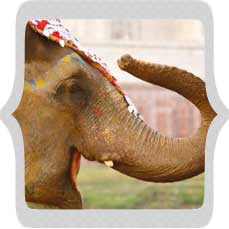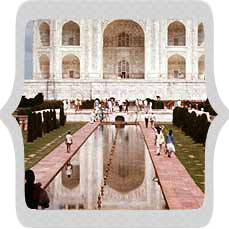 The garden according to the holy Koran is symbolic of paradise. As Islam was born in the arid region of Arabia, the vision of a lush green, well-laid out and watered garden came to be associated with life and paradise. In the course of time green became symbolic of Islam. Muslims also venerate water because it was scare in the Arabian Desert- the birthplace of Islam. According to Islam there are four rivers in paradise one each of water, milk, wine and honey. The concept of these four rivers flowing through the garden of paradise led to the Charbagh style of garden planning.
The garden according to the holy Koran is symbolic of paradise. As Islam was born in the arid region of Arabia, the vision of a lush green, well-laid out and watered garden came to be associated with life and paradise. In the course of time green became symbolic of Islam. Muslims also venerate water because it was scare in the Arabian Desert- the birthplace of Islam. According to Islam there are four rivers in paradise one each of water, milk, wine and honey. The concept of these four rivers flowing through the garden of paradise led to the Charbagh style of garden planning.Leaving the entrance gateway you can see a sprawling garden in front of you, which goes all the way up to the plinth of the Taj Mahal. The beauty of the Taj Mahal is accentuated by the garden laid out in the Persian Charbagh (four garden plan) style. The entire area of the Taj complex is 580 m (1,902 ft) by300 m (984 ft), while the garden alone makes up an area of 300 m (984 ft) by 300 m (984 ft).
The Mughals originated from the arid regions of Central Asia. They never quiet lost their longing for water and often created well laid out gardens with canals and different waterworks. In the course of time they started building tombs, which were located at the center of beautiful gardens. The Taj Mahal has an impressive watercourse, which neatly divides the garden into four equal parts and heightens the flawless symmetry of the entire complex.
The canals and waterworks within the Charbagh provide a grand reflection of the Taj, further emphasizing the imagery of the paradise. The Muslims regard the Koran as a mirror image of a tablet in heaven, while the ‘Tree of Life’ grows upside down in the garden within the paradise. The architects who built the Taj Mahal made the canals and the waterworks in the garden, with the purpose of generating an upside down image of the Taj, to gel with the divine inspiration.
 After the completion of Taj Mahal each garden within the Charbagh was divided into 16 flowerbeds, making a total of 64. It is said that each flowerbed was planted with 400 plants. Trees were planted carefully in accordance with the symmetry of the overall plan. The trees, which were generally preferred, were either cypress (Cuprussus) (signifying death) or different fruit bearing trees (signifying life). These trees housed some of the most exotic birds, all of which added to the breathtaking environs of the Taj. The water channels crisscrossing the garden used to be full of colorful fish of various species. Special care was taken to maintain the garden, its waterworks as members of the royal family frequented it and stayed in the guesthouse (mehmankhana) near it.
After the completion of Taj Mahal each garden within the Charbagh was divided into 16 flowerbeds, making a total of 64. It is said that each flowerbed was planted with 400 plants. Trees were planted carefully in accordance with the symmetry of the overall plan. The trees, which were generally preferred, were either cypress (Cuprussus) (signifying death) or different fruit bearing trees (signifying life). These trees housed some of the most exotic birds, all of which added to the breathtaking environs of the Taj. The water channels crisscrossing the garden used to be full of colorful fish of various species. Special care was taken to maintain the garden, its waterworks as members of the royal family frequented it and stayed in the guesthouse (mehmankhana) near it.
 Taj Mahal is built on a high plinth, which has four tapering minarets at each corner. At the center of this plinth is an octagonal structure comprising of a central hall, with four smaller halls grouped around it. A central bulbous dome stands atop the roof of the Taj that is surrounded by four chhatris (domed canopy, supported by pillars, mainly seen in Hindu or local monuments and sometimes in Islamic buildings). The Taj Mahal is a two-storied structure, each having arched recesses with a highly decorated iwan in the middle. The tombs of Mumtaz Mahal and Shahjahan are actually located in the basement, while their replicas are placed directly above in the upper hall.
Taj Mahal is built on a high plinth, which has four tapering minarets at each corner. At the center of this plinth is an octagonal structure comprising of a central hall, with four smaller halls grouped around it. A central bulbous dome stands atop the roof of the Taj that is surrounded by four chhatris (domed canopy, supported by pillars, mainly seen in Hindu or local monuments and sometimes in Islamic buildings). The Taj Mahal is a two-storied structure, each having arched recesses with a highly decorated iwan in the middle. The tombs of Mumtaz Mahal and Shahjahan are actually located in the basement, while their replicas are placed directly above in the upper hall. The story of Taj Mahal is inseparable from the life of Mumtaz Mahal who was the chief queen of Shahjahan. Prince Khurram, as Shahjahan was known before he became the Mughal emperor, was a handsome twenty-year-old man, when he was betrothed to Mumtaz. It is said that the imperial capital of Agra was agog with the description of her beauty at the time of the betrothal. The maiden name of Mumtaz Mahal was Arjumand Banu Begum. Prince Khurram had been married twice before he met and married Mumtaz Mahal. Mumtaz bore him 13 children and accompanied him wherever he went.
The story of Taj Mahal is inseparable from the life of Mumtaz Mahal who was the chief queen of Shahjahan. Prince Khurram, as Shahjahan was known before he became the Mughal emperor, was a handsome twenty-year-old man, when he was betrothed to Mumtaz. It is said that the imperial capital of Agra was agog with the description of her beauty at the time of the betrothal. The maiden name of Mumtaz Mahal was Arjumand Banu Begum. Prince Khurram had been married twice before he met and married Mumtaz Mahal. Mumtaz bore him 13 children and accompanied him wherever he went. Next day the prince went to emperor Shah Jahan to seek his permission to marry Arjumaand Banu. Emperor Jahangir gave the permission at once but it took five years for him to marry his beloved. Meanwhile he was married to a Persian Princess Quandari Begum due to some political reasons.
Next day the prince went to emperor Shah Jahan to seek his permission to marry Arjumaand Banu. Emperor Jahangir gave the permission at once but it took five years for him to marry his beloved. Meanwhile he was married to a Persian Princess Quandari Begum due to some political reasons. Location: Shilpgram, Near Taj Mahal, Agra
Location: Shilpgram, Near Taj Mahal, Agra The architects planned water devices at the Taj Mahal in a very systematical manner. The water for Taj Mahal was drawn from the river and came from a number of underground pipes. Purs (a rope and bucket pulled by bullocks) were used for drawing water from the river and from there the water was transferred to a huge storage tank. Again thirteen purs were used to pump the water from the tank. From this tank, the water was taken into another huge storage tank through an over-head water-channel.
The architects planned water devices at the Taj Mahal in a very systematical manner. The water for Taj Mahal was drawn from the river and came from a number of underground pipes. Purs (a rope and bucket pulled by bullocks) were used for drawing water from the river and from there the water was transferred to a huge storage tank. Again thirteen purs were used to pump the water from the tank. From this tank, the water was taken into another huge storage tank through an over-head water-channel.